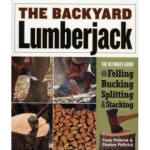 Review by Review by
Richard SumrallWhat does it take to bring a tree from the
forest to the fireplace? In their book "The Backyard Lumberjack" father and
son woodsmen Frank and Stephen Philbrick explain how to fell a tree and the
reasons they enjoy lumberjacking: the rigorous exercise, saving money, the
social aspects of an open fire, and of course, a warm house. Their
description of the lumberjacking process follows five basic steps: felling,
bucking, splitting, stacking, and burning.
Felling
Before you venture into the forest to bring down a tree it's recommended
that you acquire the proper gear and equipment. The most important piece of
equipment is the chain saw. The authors explain how to select the best chain
saw for your needs. Some of the specifications to consider include the saw
weight, bar size, and the RPMs (revolutions per minute). Other pieces of
equipment include chaps (protective leggings), head gear (the head, eyes,
face, ears), gloves, assorted handsaws, axes/hatchets, mauls (for
woodsplitting), and heave-hos (to roll the lumber). The authors also provide
a handy chart that rates different trees as "best bets for BTUs," or units
of energy for heating. The winners? Hickory, black locust, and ironwood with
BTUs over 26 million. The authors also demonstrate through a series of
photographs the proper method of making the felling cut and how to safely
fell a tree.

Bucking
Bucking is a lumberjacking term for reducing a tree on the ground to
stove length pieces. This involves a two-step process: limbing (cutting off
any limbs/branches to gain access to the trunk) and cutting the trunk into
the desired pieces. When bucking a tree, remember an important safety tip --
if you're working with a sawing partner, don't relieve the trunk pressure
points he's counting on. Many of the pieces of gear and equipment mentioned
earlier are used during bucking.
Splitting
Depending on your point of view, splitting the bucked wood is either the
most enjoyable or most miserable task in the lumberjack experience.
Splitting the wood with your maul reduces large sections of the trunk into
smaller, faster drying pieces. The two common techniques for wielding a maul
are the overhead explosion and the sideways slam. The overhead uses more
power from your upper back, while the sideways relies on increased torque
(as in throwing a baseball). When you're splitting an unusually large or
difficult piece you can try a technique known as peeling. Peeling works
around the edges of the lumber; in other words you are using your maul to
peel away slices of the wood until you have a manageable inner core.
[to top of second column] |

Stacking
Stacking your wood serves two purposes: it allows the wood to air
dry and it makes the wood accessible without the woodpile collapsing
and causing an injury. Wood stacks can be reinforced with walls,
posts, or standing trees serving as "bookends." More elaborate
stacks include cribbing (a freestanding pile that spreads the
pressure forces through crosshatching the pieces) and wood chimneys
(hollow beehive shapes that draw the air in, up, and out). For the
serious lumberjack or wood-burning enthusiast the authors include
designs for an attached or detached woodshed.
Burning
If you're going to expend this much energy and effort to secure
wood for burning, you will want to make the right choices for your
method of burning and heating. There are several options to consider
-- outdoor furnaces, masonry heaters, fireplaces, and woodstoves.
Outdoor furnaces are external units that burn wood to heat water for
your household purposes. Masonry heaters are more costly but are
extremely efficient and can heat large spaces. Fireplaces are
entertaining and lend atmosphere to a home but are less effective at
heating a given space. Depending on their location and maintenance
woodstoves can be very reliable sources of heat. Your decision on a
particular heat source will depend on the area you're trying to
heat, the kind of wood you'll be burning, and the amount of time you
devote (or choose not to devote) to tending and maintaining the
fire.
"The Backyard Lumberjack" is an entertaining and informative book
on a subject that has been somewhat overlooked in the current
literature. According to the authors the book is intended for
"anyone who has the regional resources, the physical wherewithal,
and the desire to take down trees." The allure of this activity was
poignantly described by Henry David Thoreau, who once noted that
"firewood warms you twice, once when you split it, and once when you
burn it." This book is recommended to anyone interested in learning
the safe and efficient methods of lumberjacking and tree felling.
[Richard Sumrall,
Lincoln Public
Library District]
 |